
How to Use CNC SHIELD V3: Examples, Pinouts, and Specs
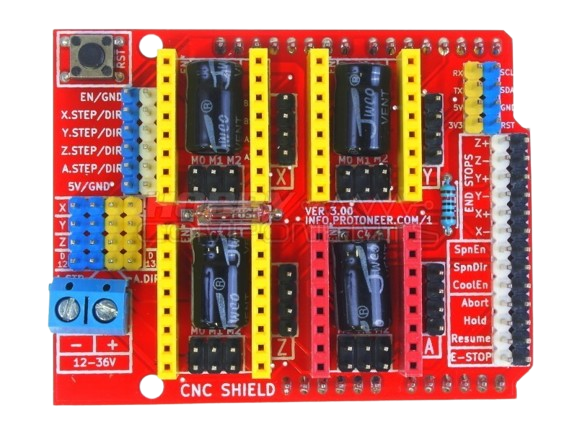
 Design with CNC SHIELD V3 in Cirkit Designer
Design with CNC SHIELD V3 in Cirkit DesignerIntroduction
The CNC SHIELD V3, manufactured by INFO PROTONER (Part ID: CNC SHIELD), is a versatile control board designed for CNC machines. It simplifies the process of connecting stepper motors, limit switches, and other peripherals, making it an essential component for DIY CNC projects and professional applications. The shield is compatible with Arduino-based systems, enabling precise control of multiple axes and seamless integration with GRBL firmware.
Explore Projects Built with CNC SHIELD V3
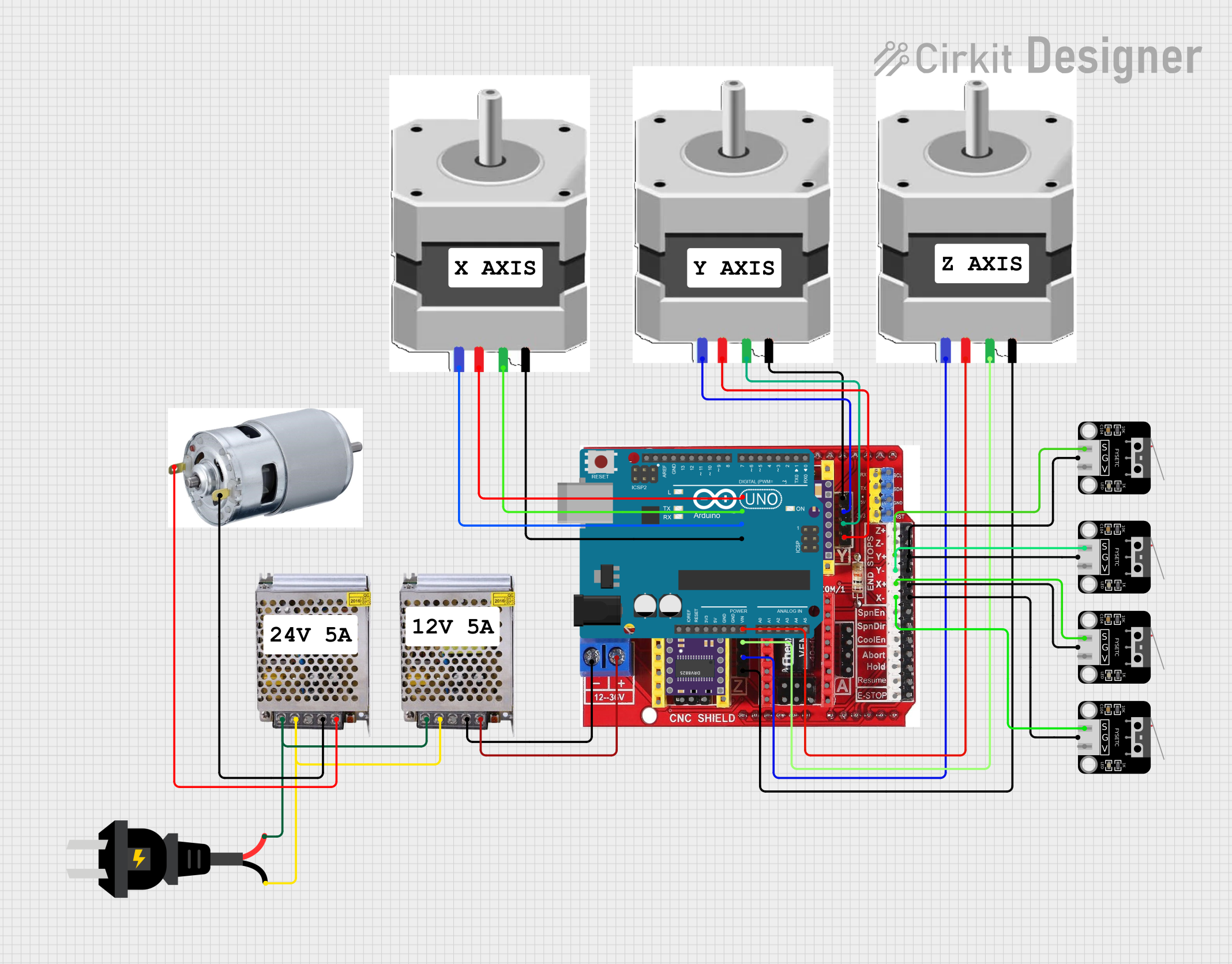
 Open Project in Cirkit Designer
Open Project in Cirkit Designer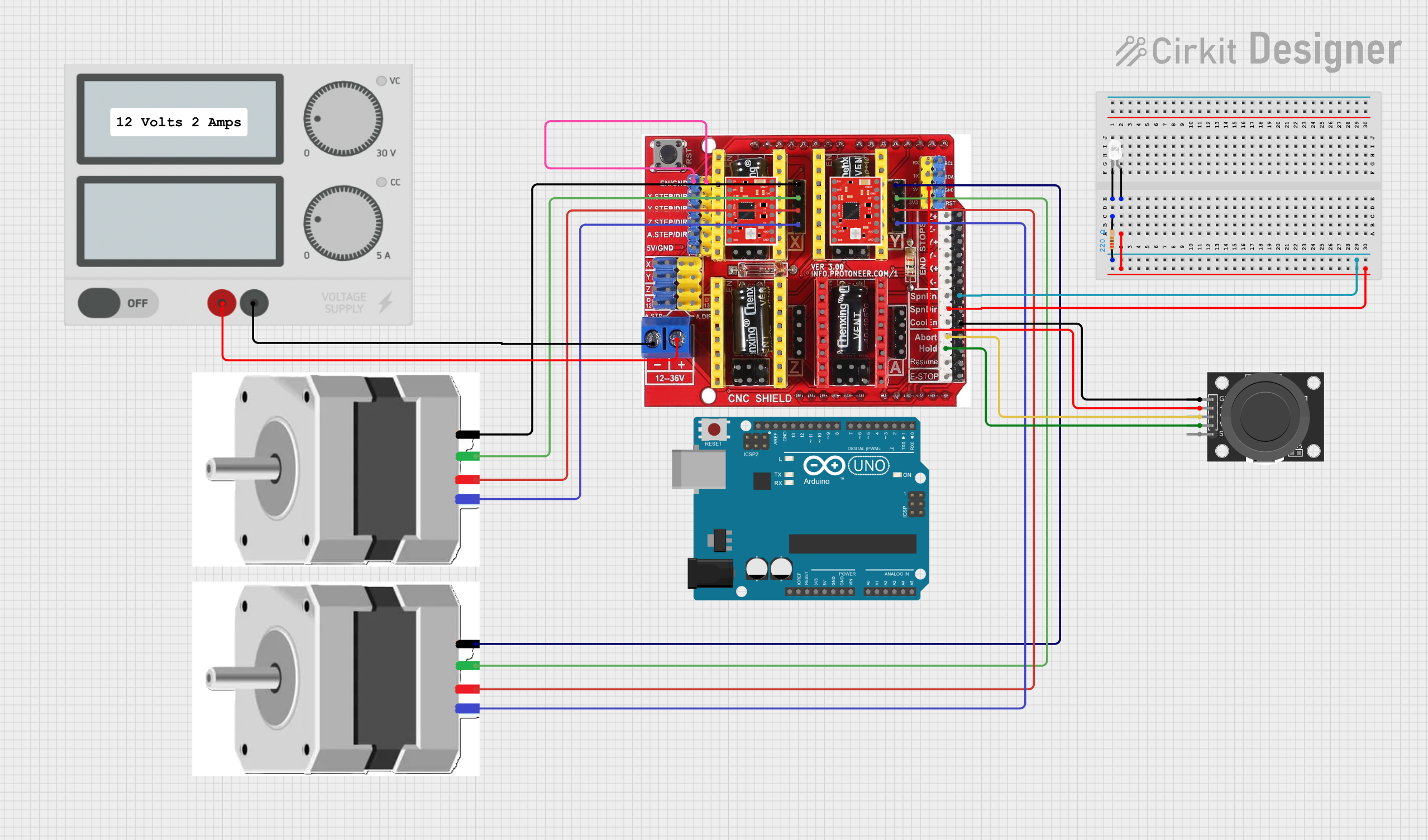
 Open Project in Cirkit Designer
Open Project in Cirkit Designer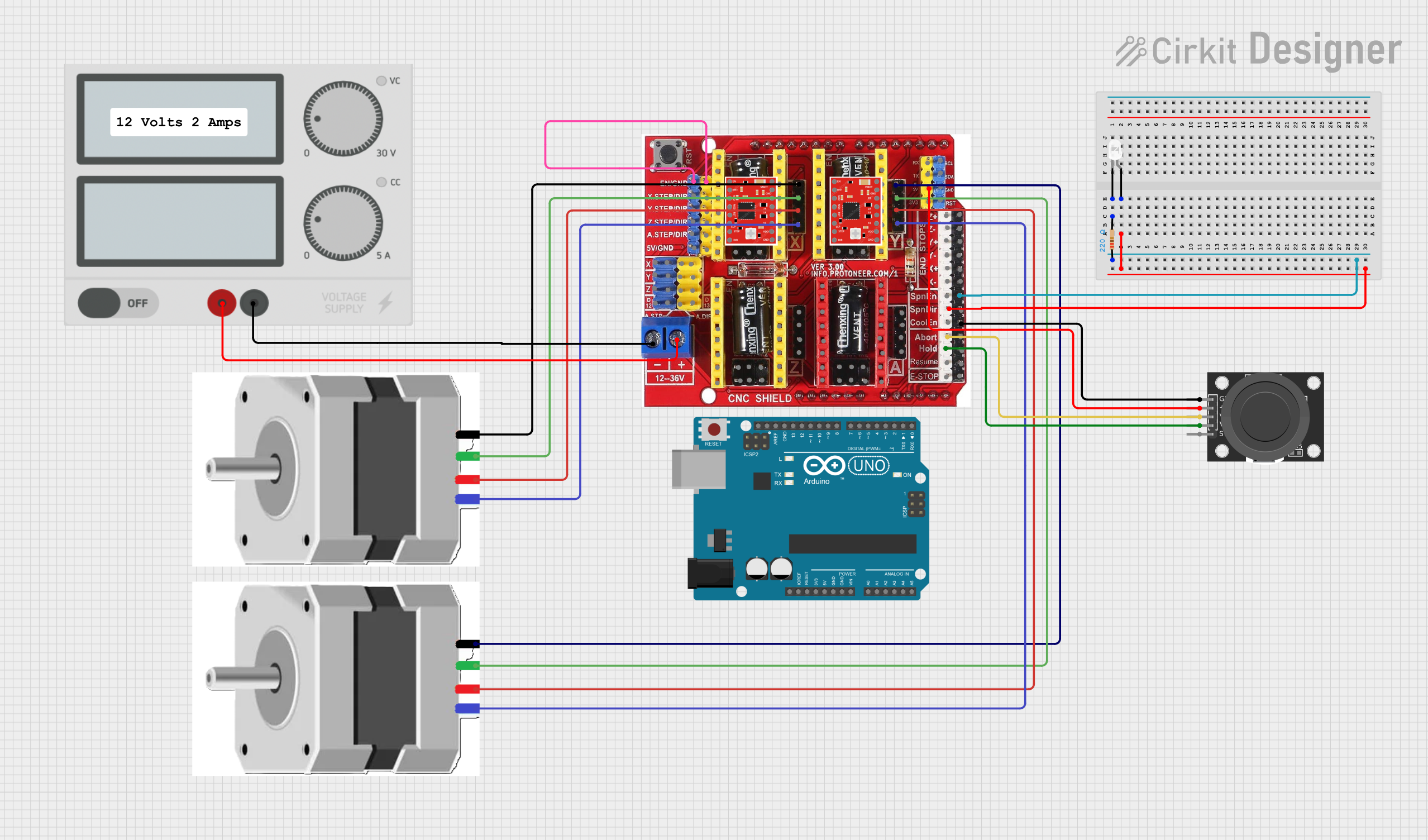
 Open Project in Cirkit Designer
Open Project in Cirkit Designer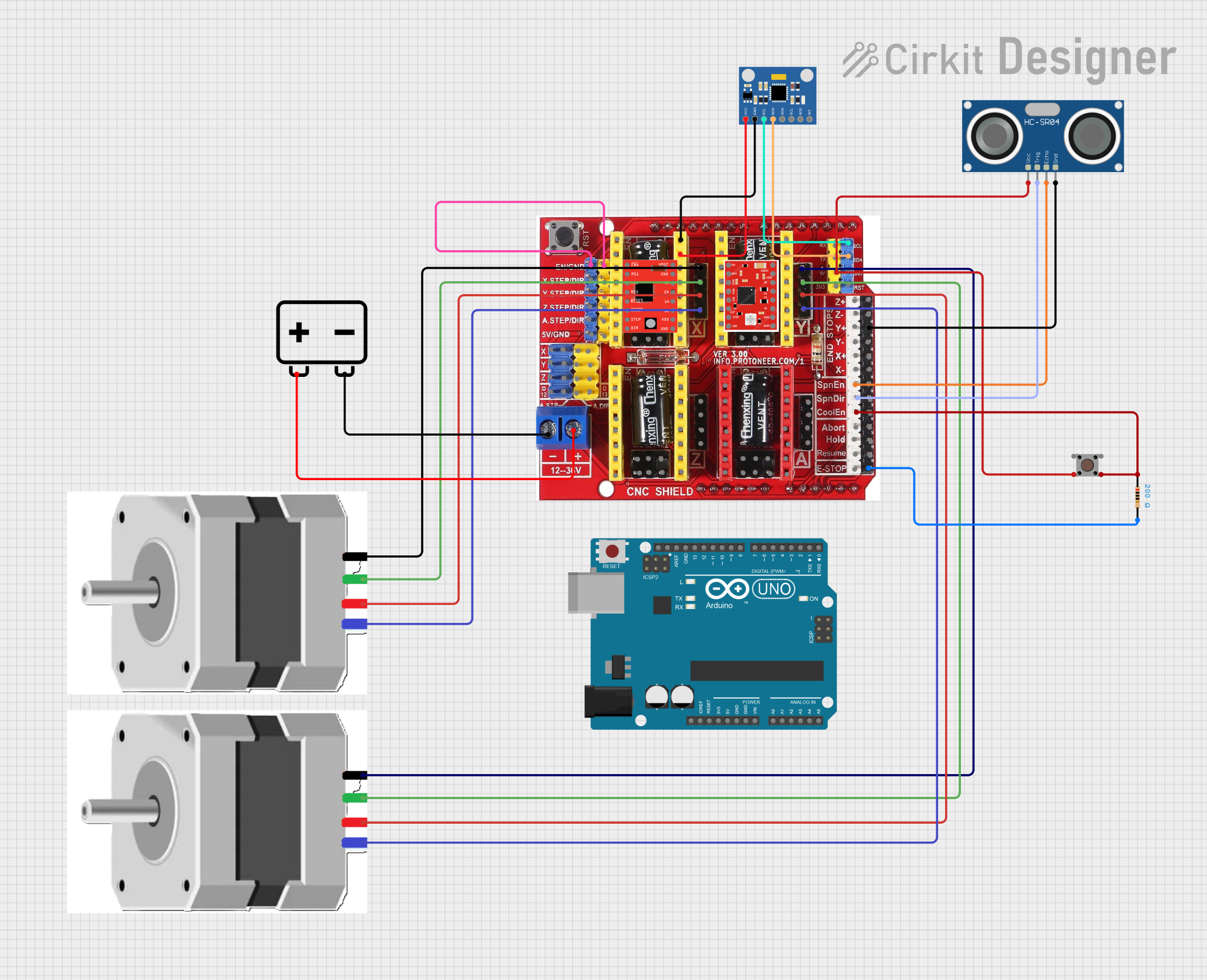
 Open Project in Cirkit Designer
Open Project in Cirkit DesignerExplore Projects Built with CNC SHIELD V3

 Open Project in Cirkit Designer
Open Project in Cirkit Designer
 Open Project in Cirkit Designer
Open Project in Cirkit Designer
 Open Project in Cirkit Designer
Open Project in Cirkit Designer
 Open Project in Cirkit Designer
Open Project in Cirkit DesignerCommon Applications and Use Cases
- DIY CNC machines (e.g., routers, laser engravers, and 3D printers)
- Robotics and automation projects
- Educational and prototyping purposes
- Small-scale manufacturing and engraving tasks
Technical Specifications
The CNC SHIELD V3 is designed to work with Arduino UNO and similar boards, providing a compact and efficient solution for CNC control. Below are the key technical details:
General Specifications
- Power Supply Voltage: 12V to 36V DC (via external power input)
- Stepper Motor Driver Compatibility: A4988, DRV8825, and similar modules
- Number of Axes Supported: 3 (X, Y, Z) with an optional 4th axis (A)
- Microstepping Support: Configurable via jumpers
- Limit Switch Support: 6 inputs (2 per axis)
- Spindle Control: PWM output for spindle speed control
- Dimensions: 68mm x 53mm (approx.)
Pin Configuration and Descriptions
The CNC SHIELD V3 features a well-organized pin layout for easy connection. Below is a detailed description of the pins:
Stepper Motor Driver Sockets
| Pin Name | Description |
|---|---|
| VMOT | Power input for stepper motors (12V-36V DC) |
| GND | Ground connection for stepper motor power |
| STEP | Step signal input for motor movement |
| DIR | Direction signal input for motor rotation |
| EN | Enable signal for the stepper driver |
Arduino Header Pins
| Pin Name | Description |
|---|---|
| X_STEP, Y_STEP, Z_STEP, A_STEP | Step signal pins for X, Y, Z, and optional A axis |
| X_DIR, Y_DIR, Z_DIR, A_DIR | Direction signal pins for X, Y, Z, and optional A axis |
| X_EN, Y_EN, Z_EN, A_EN | Enable signal pins for X, Y, Z, and optional A axis |
| Spindle PWM | PWM output for spindle speed control |
| Limit Switches | Inputs for X, Y, and Z axis limit switches (2 per axis) |
Additional Features
- Microstepping Configuration: Jumpers under each driver socket allow setting microstepping modes (e.g., full step, half step, 1/4 step, etc.).
- Spindle Enable Pin: Dedicated pin to enable or disable the spindle motor.
- I2C and Serial Communication: Compatible with Arduino for advanced control.
Usage Instructions
How to Use the CNC SHIELD V3 in a Circuit
Install Stepper Motor Drivers:
- Insert A4988 or DRV8825 stepper motor drivers into the sockets, ensuring correct orientation.
- Adjust the current limit on the drivers as per your stepper motor specifications.
Connect Stepper Motors:
- Attach the stepper motor wires to the corresponding X, Y, Z, or A axis terminals.
- Ensure proper wiring to avoid incorrect motor operation.
Connect Limit Switches:
- Wire the limit switches to the designated pins for each axis.
- Use normally open (NO) or normally closed (NC) switches as required by your setup.
Power the Shield:
- Connect a 12V-36V DC power supply to the VMOT and GND terminals.
- Ensure the power supply can handle the current requirements of your stepper motors.
Connect to Arduino:
- Mount the CNC SHIELD V3 onto an Arduino UNO or compatible board.
- Upload GRBL firmware to the Arduino for CNC control.
Configure GRBL Settings:
- Use a GRBL-compatible software (e.g., Universal G-code Sender) to configure axis steps, limits, and other parameters.
Important Considerations and Best Practices
- Cooling: Use heatsinks and/or a cooling fan for stepper motor drivers to prevent overheating.
- Microstepping: Configure microstepping jumpers based on your application's precision and speed requirements.
- Power Supply: Ensure the power supply voltage matches the requirements of your stepper motors and drivers.
- Firmware: Always use the latest version of GRBL firmware for optimal performance and compatibility.
Example Arduino Code
Below is an example of how to control a stepper motor connected to the X-axis using the CNC SHIELD V3:
// Example: Basic stepper motor control for CNC SHIELD V3
// Connect the CNC SHIELD V3 to an Arduino UNO
// Ensure the stepper motor driver is properly installed
#define X_STEP_PIN 2 // X-axis step pin
#define X_DIR_PIN 5 // X-axis direction pin
#define X_EN_PIN 8 // X-axis enable pin
void setup() {
pinMode(X_STEP_PIN, OUTPUT); // Set step pin as output
pinMode(X_DIR_PIN, OUTPUT); // Set direction pin as output
pinMode(X_EN_PIN, OUTPUT); // Set enable pin as output
digitalWrite(X_EN_PIN, LOW); // Enable the stepper motor driver
}
void loop() {
digitalWrite(X_DIR_PIN, HIGH); // Set direction to forward
for (int i = 0; i < 200; i++) { // Move 200 steps (1 revolution for 1.8° motors)
digitalWrite(X_STEP_PIN, HIGH);
delayMicroseconds(500); // Step pulse width
digitalWrite(X_STEP_PIN, LOW);
delayMicroseconds(500); // Step pulse interval
}
delay(1000); // Wait 1 second
digitalWrite(X_DIR_PIN, LOW); // Set direction to reverse
for (int i = 0; i < 200; i++) { // Move 200 steps in reverse
digitalWrite(X_STEP_PIN, HIGH);
delayMicroseconds(500);
digitalWrite(X_STEP_PIN, LOW);
delayMicroseconds(500);
}
delay(1000); // Wait 1 second
}
Troubleshooting and FAQs
Common Issues and Solutions
Stepper Motors Not Moving:
- Cause: Incorrect wiring or loose connections.
- Solution: Double-check motor wiring and ensure all connections are secure.
Overheating Stepper Drivers:
- Cause: Excessive current or insufficient cooling.
- Solution: Adjust the current limit on the driver and add heatsinks or a cooling fan.
Limit Switches Not Working:
- Cause: Incorrect wiring or GRBL configuration.
- Solution: Verify limit switch wiring and check GRBL settings for proper configuration.
Spindle Not Responding:
- Cause: Incorrect PWM wiring or GRBL settings.
- Solution: Ensure the spindle is connected to the correct PWM pin and verify GRBL spindle settings.
FAQs
Can I use the CNC SHIELD V3 with other Arduino boards? Yes, it is compatible with most Arduino boards that have the same pinout as the Arduino UNO.
What stepper motor drivers are supported? The shield supports A4988, DRV8825, and similar stepper motor drivers.
How do I configure microstepping? Use the jumpers under each driver socket to set the desired microstepping mode.
Is the CNC SHIELD V3 compatible with GRBL? Yes, it is fully compatible with GRBL firmware for CNC control.
This concludes the documentation for the CNC SHIELD V3.